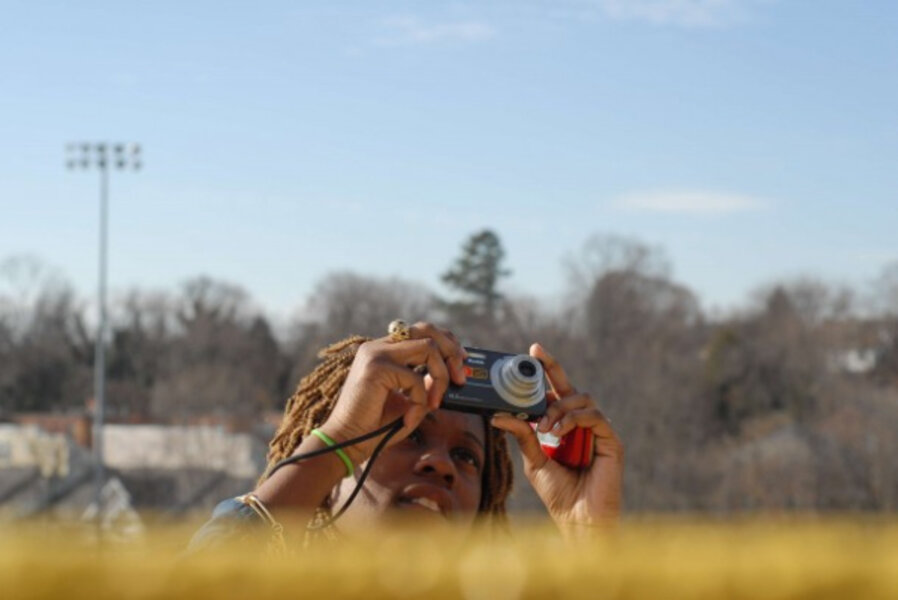Critical Exposure: students focus on reforming schools
Loading...
The photo shows a wall-mounted clock with chunks of glass missing between one and three o’clock.
"This photo depicts a broken clock in a classroom. It shows how time is lost and how simple things are broken, [and how] a simple thing can affect us in such a big way,” the photographer, identified only as Khalid, wrote.
Khalid took the photo as evidence of what needed fixing at his school, Ballou Senior High School. Ballou is in Washington D.C’.s eighth ward, which is known for high rates of crime and poverty. Though Ballou has an accomplished school marching band and much to celebrate, it, like many schools in DC, has suffered from deteriorating facilities.
That an inner-city public school has broken clocks and lockers and, generally, could use extra funding isn’t surprising; it’s the type of image that often finds its way into discussions about what’s wrong with public schools.
It’s also not surprising that a local organization, Critical Exposure, is working to remedy what it says are inequalities in the public school system, where poor neighborhoods have underfunded and under-equipped schools.
What is surprising, though, is how the organization, working with students like Khalid, tries to remedy what it calls a systemic problem.
Founded in 2004, Critical Exposure teaches students in disadvantaged schools how to document, with photos, the bad – and the good – of their school experiences. At the same time, the organization advocates changes in education public policy, often relying on the power of the lens.
Adam Levner, the organization’s executive director and co-founder, says that Critical Exposure is distinctive for its blend of art and advocacy.
“There are lots of great organization that teach you how to express [yourself] through art. There are lots of great organizations that involve youth in reform efforts. But there are very few programs or initiatives that systematically and intentionally teach students how to use their voices and their stories and their images as concrete tools to secure the kinds of changes they want to see,” he said.
Public policy is normally the province of self-described “wonks,” those who, so the word suggests, traffic in big ideas, not so much in the gritty problems that occupy most of our day-to-day lives; say, a school’s leaking roof or broken water fountain.
But Mr. Levner, a former 5th -grade teacher, said that changing public policy is “critical as part of school reform.”
“That’s what makes [reform] systemic,” he said. “That’s what keeps it from being a Band-Aid and just a quick infusion of a few dollars to fix up a few tiles in one classroom.”
Still, raising the public’s awareness about schools’ problems remains a core part of Critical Exposure’s mission. Each year, the organization holds an exhibit of student photos, accompanied by often-detailed captions, at a local art gallery.
“It’s amazing to watch students walk into a nice art gallery, usually for the first time in their lives, and see their photographs blown up and framed and hanging on a wall, and have a whole bunch of strangers standing around, looking at their work, talking about their work,” Levner said. “Equally or more important is that those photos are always accompanied by writing, captions, where the students are telling their stories. For a lot of students, seeing people stand there and read their words is really powerful.”
Students have learned, too, that their photos can reach more than just strangers in an art gallery. Levner said that, as part of Critical Exposure’s work with other organizations to increase funding for Maryland public schools’ facilities, students came to the state capitol in Annapolis and whisked away state legislators to share their photos and stories. One legislator was so taken by the photos that he distributed copies to fellow lawmakers. The legislator, according to Levner, said that the photos helped in passing a bill that increased funding for the schools.
And in D.C., Critical Exposure was part of a successful campaign that secured $200 million in annual funding to modernize public schools.
Still, the organization, like many nonprofits, has had challenges with its own funding. Its revenue comes from a combination of grants, individual donors, and fee-for-service programs. Critical Exposure, Levner added, has been extremely fortunate to benefit from the subsidized labor of dedicated AmeriCorps VISTAs.
But Levner said the organization is still working to develop what he considers a sustainable funding model.
“Fundraising has been a combination of tireless searching for funds and trying to be as creative as we can about different ways to generate revenue,” he said.
It’s easy to become fixated on everything that’s wrong with public schools. Newspapers titillate us with stories of urban blight and dreams deferred, and countless films show us scenes of savage inner-city students running amok – that is, until a daring hero or heroine, in one miraculous swoop, turns the school around.
Certainly there are problems with our public schools, Levner admitted. But it’s important that programs like Critical Exposure also expose what’s good and hopeful about schools. To the surprises of many people, students are very interested in – not indifferent to – having good school experiences, he said.
Moreover, students need to feel as though the schools are worth fighting for, he said.
“It’s really hard to get people to invest in something that they think is completely a wreck, that there is no good in,” he said. “We want to make sure that we’re not giving people the impression that public schools are a failure and we need to walk away from them."
• This story originally appeared on Dowser.org.
• For more stories about people making a difference, go here.






